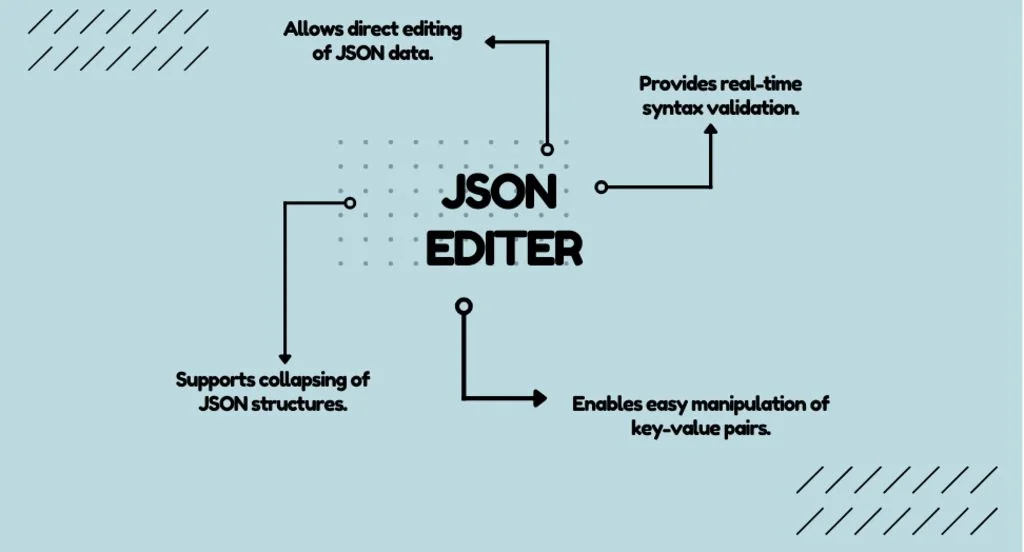JSON Editor
Understanding Why JSON Editor is needed

What is JSON?
JSON (JavaScript Object Notation) is a lightweight data-interchange format that is easy for humans to read and write, and easy for machines to parse and generate. It is a text format that is language-independent, making it ideal for exchanging data between a server and a client or between different parts of an application.
What is a JSON Editor?
A JSON Editor is a tool that allows you to create, edit, and format JSON (JavaScript Object Notation) data. These editors often provide syntax highlighting, error detection, and other features to make working with JSON easier.
- Syntax highlighting: Provides color coding to differentiate between different elements like keys, values, and brackets.
- Validation: Checks the JSON data to ensure it follows proper structure and flags any errors.
- Auto-formatting: Automatically formats the JSON data to be readable and properly indented.
- Code folding: Allows sections of the JSON data to be collapsed or expanded for easier navigation.
- Search and replace: Enables searching for specific strings and replacing them within the JSON data.
- Drag and drop: Facilitates moving of elements within the JSON structure by dragging and dropping.
- Schema support: Validates JSON data against a predefined schema to ensure conformity.
- Undo/Redo: Provides undo and redo functionality to easily revert changes.
- Export/Import: Allows JSON data to be exported to or imported from external files.
- Theme customization: Offers options to change the editor's theme and appearance.
What are the top 3 JSON Editors?
What are the features of JSON
- Lightweight: JSON is lightweight and easy to read and write.
- Self-Describing: JSON uses human-readable text to transmit data objects.
- Language Independent: JSON format is language-independent, but it uses conventions that are familiar to programmers of the C family of languages.
- Easy to Parse: JSON data can be easily parsed by any standard programming language.
- Data Interchange: JSON is often used to exchange data between a server and web application.
- Hierarchical Structure: JSON can represent complex data structures like objects and arrays naturally.
- Support for Null Values: JSON supports null values, making it adaptable to various data types.
Key Features to Look for When Choosing a JSON Editor
When selecting a JSON editor, there are several key features you should look for to ensure you have a powerful and efficient tool for working with JSON data.
Robust JSON formatting and syntax highlighting are essential for quickly identifying and resolving issues within your JSON files. Advanced editors will provide options to automatically format JSON with customizable indentation, spacing, and bracketing to improve readability. Syntax highlighting further enhances this by using distinct colors for different elements such as keys, values, and data types. This visual distinction allows developers to quickly scan and comprehend the structure of complex JSON documents. Additionally, many modern JSON editors offer real-time error detection, flagging syntax errors or invalid data types as you type. This immediate feedback streamlines the debugging process, reducing the time spent on troubleshooting and increasing overall productivity. Some advanced tools even provide schema validation, ensuring that your JSON adheres to a predefined structure, which is particularly useful when working with APIs or configuration files. By leveraging these powerful features, developers can significantly improve their workflow, minimize errors, and produce more reliable JSON-based applications and services. Seamless JSON validation is another critical capability, allowing you to instantly check the structure and syntax of your JSON to catch errors before they cause problems. The best JSON editors will integrate validation directly into the editing experience.
Equally important are editing features that streamline your workflow, such as multi-cursor editing, find and replace functionality, and the ability to quickly navigate and manipulate JSON objects and arrays. Look for an editor that provides an intuitive interface and keyboard shortcuts to boost your productivity. Furthermore, consider an editor that offers robust code folding capabilities, allowing you to collapse and expand sections of your JSON file for improved readability. Syntax highlighting and auto-completion features can significantly reduce errors and accelerate your coding process. Advanced editors may also include built-in linting tools to catch potential issues in real-time, ensuring your JSON remains valid and well-formatted. Another crucial aspect is version control integration. An editor that seamlessly connects with popular version control systems like Git can greatly enhance collaboration and help you track changes over time. Some editors even offer split-screen views, enabling you to compare different versions of your JSON side by side. Lastly, prioritize editors with strong community support and regular updates. This ensures you’ll have access to a wealth of extensions, themes, and plugins to further customize your editing experience and adapt to evolving JSON standards and best practices.
Finally, consider supplementary features like JSON schema support, JSON path querying, and the ability to view JSON data in a tree-structured format. These can greatly enhance your ability to understand complex JSON structures and make targeted changes. Moreover, look for tools that offer advanced search and filtering capabilities, allowing you to quickly locate specific data within large JSON files. Real-time validation
By prioritizing these key capabilities when choosing a JSON editor, you can find a tool that will simplify your JSON-related tasks and make you more efficient in working with this increasingly ubiquitous data format.